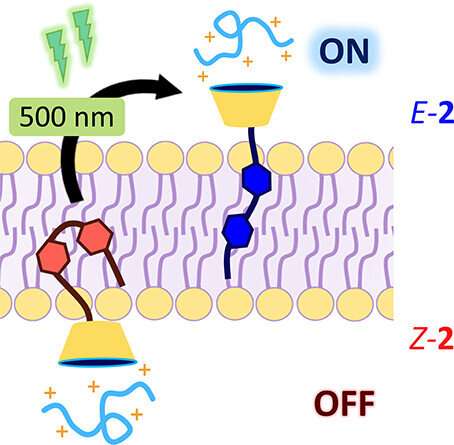This article has been reviewed according to Science X's editorial process and policies. Editors have highlighted the following attributes while ensuring the content's credibility:
fact-checked
peer-reviewed publication
proofread
Researchers report light-controlled transport of biomolecules across the cell membrane

Crossing the membrane is a major challenge on the journey through the cell. Large biomolecules usually benefit from different transport strategies to overcome the lipid bilayer, so the design and synthesis of new carriers is key for the delivery of hydrophilic substances, such as pharmaceuticals, into the cell. Among these transporters, those using light as stimulus are particularly appealing due to their high precision, no chemical waste production and the possibility of remote application.
In collaboration with a team from the Universidade Nova de Lisboa (NOVA), researchers from the Center for Research in Biological Chemistry and Molecular Materials (CiQUS) at University of Santiago de Compostela reported new light-responsive membrane transporters for the translocation of peptide cargos inside living cells.
"Our design relied on calixarene-based receptors with an azobenzene unit that can be applied as photoresponsive counterion to gain control over the transport of cationic peptides," said Prof. Javier Montenegro, Principal Investigator at CiQUS. Counterions are oppositely charged ions that are attracted to the charged compound, forming charge-neutralized complexes with higher membrane permeability in this case.
When light irradiated, azobenzenes units change their configuration from a more polar to a more hydrophobic conformation, successfully making their way into the cytosol. "The dynamic control of the structure and polarity of counterion activators by using light offers a promising conceptual strategy to develop stimuli responsive membrane carriers," explained Dr. Nuno Basílio, researcher at NOVA and co-author of the work recently published in the Journal of the American Chemical Society (JACS).
According to the authors, the synthesis of such molecular photoswitches shows their potential for the light-triggered delivery of large biomolecules and envisage new possibilities in remotely controlled systems for pharmaceutical applications.
More information: Joana N. Martins et al, Photoswitchable Calixarene Activators for Controlled Peptide Transport across Lipid Membranes, Journal of the American Chemical Society (2023). DOI: 10.1021/jacs.3c01829
Journal information: Journal of the American Chemical Society
Provided by Center for Research in Biological Chemistry and Molecular Materials (CiQUS)





















